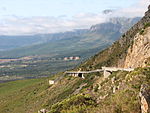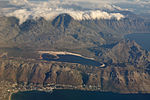Steenbras Upper Dam

Steenbras Upper Dam is an earth-fill type dam located in the Hottentots Holland Mountains above Gordons Bay in the Western Cape, South Africa. It impounds the Steenbras River upstream of the older Steenbras Dam. The dam was constructed in 1977 for the City of Cape Town and serves mainly for municipal and industrial use. The hazard potential of the dam has been ranked high (3). Steenbras Upper Dam also functions as the upper reservoir of the city's Steenbras pumped-storage hydroelectric power scheme, with a lower reservoir at the foot of the mountain. It is also linked by an open canal and pipeline to the Rockview Dam, which acts as the upper reservoir of the Palmiet Pumped Storage Scheme, a separate pumped-storage scheme operated by Eskom and the Department of Water and Sanitation. The link allows water from the Palmiet River to be transferred to the dam.
Excerpt from the Wikipedia article Steenbras Upper Dam (License: CC BY-SA 3.0, Authors, Images).Steenbras Upper Dam
Steenbras Dam Road,
Geographical coordinates (GPS) Address Nearby Places Show on map
Geographical coordinates (GPS)
| Latitude | Longitude |
|---|---|
| N -34.168055555556 ° | E 18.901388888889 ° |
Address
Steenbras Dam Road (Steenbras Pass Road)
Steenbras Dam Road
7150 , Gordon's Bay
Western Cape, South Africa
Open on Google Maps




